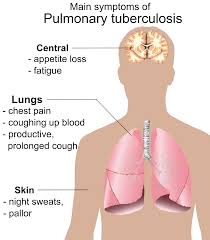CHRONIC PULMONARY tuberculosis in adults is predominantly a disease of the pulmonary parenchyma. As mentioned, most if not all chronic pulmonary tuberculosis in the adult is due to the evolution of foci seeded during the preallergic bacteremic phase of the initial infection. This evolution may occur either fairly promptly or after long periods of quiescence when subtle changes in the host resistance or other factors produce conditions favorable for this to occur. Whether or not a latent period intervenes, these loci gain largest size and, therefore, are most prone to reactivation in the apicalpostenor aspects o-f the lung, in which local factors are.most favorable to bacterial growth.
The earliest infiltrate in chronic pulmonary tuberculosis appears most commonly in the posterior or apical segment of an upper lobe or the apical segment of a lower lobe, beginning as a small patch of bronchopneumonia surrounding a growing colony of tubercle bacilli. This inflammatory reaction in the hypersensitive host produces an alveolar exudate containing fibrin-rich fluid and a mixture of inflammatory cells. With increasing intensity of the inflammatory reaction, tissue necrosis of a type quite characteristic of tuberculosis and terhied caseous (of a cheesy consistency) develops. As long as it persists intact, caseous necrosis is an effective mechanism of host defense, inhibiting bacterial growth and causing the death of most organisms, presumably because of low oxygen tension and probably other factors as well. (Invariably, however, a few metabolically dormant organisms persist.) The critical factors reversing this favorable trend are the tendency of the caseous material eventually to liquefy and the access of liquefied material to the bronchial tree. Bronchial drainage of liquefied material produces a cavity in open communication with inspired air, in which high oxygen tension enhances bacterial multiplication and from which secretions rich in bacteria are spread via the bronchi to other areas of the lung and to the outside environment. Once reactivation occurs, the progressive nature of tuberculosis in the hypersensitive host is largely due to the combination of these three factors: the tendency of caseous necrosis to liquefy, the access of liquefied and infectious material to the bronchial tree, and the aerobic nature of the organisms, resulting in huge bacterial populations within open cavities.
Organisms delivered to the draining bronchus expose other areas of the lung to infection. Bronchogenic spread ipay take place by simple spillage, but is enhanced by the cough mechanisms which, because of explosive expiration followed by deep inspiration, aerosolize infectious material and then distribute it widely throughout the lung. Sooner or later new foci of disease develop. Each in turn may undergo caseous necrosis and then heal, or liquefy, slough, and produce another cavity. New lesions usually appear first within other portions of the segment or lobe initially involved. Although contiguous spread may occur, bronchial spread is more frequent, producing scattered, patchy disease. The apical posterior areas of the contralateral lung are apt to become diseased, presumably again because of local factors intrinsic to these areas favoring growth of organisms spread via the bronchi.
In addition to the exudative tissue response characteristic of progressive disease, there is usually also a productive tissue reaction characterized by giant cells and epithelioid cells forming tubercles and leading eventually to fibrosis and healing. This is particularly true in the anterior and basal portions of the lung which have a remarkable capacity to resist progressive infection. Continuing, heavy exposure to these areas from cavities above usu- ually produces gradual destruction by scarring and fibrosis rather than new necrotic areas. Almost all lesions will show some mixture of exudative and productive tissue responses, with progressive disease in one area coexisting with regression in another. Moreover, the pace and tempo of progressive disease is highly variable from one patient to the next and in the same individual at different times.
Lowered host resistance, owing to either intercurrent or genetic factors, vigorous hypersensitivity reactions, and large numbers of organisms favor acute inflammatory reactions and rapid progression, which may produce the clinical and roentgenographic picture of acute, confluent, bacterial pneumonia (tuberculous pneumonia or phthisis florida). At the other end of the spectrum, relatively effective immunity, limited hypersensitivity, and a low bacterial population favor predominantly productive lesions, slow progression, and a greater tendency to spontaneous healing. Large, thick-walled cavities in a shrunken, extensively carnified lobe (chronic fibroid tuberculosis) may persist for years without causing symptoms but serving as a constant source of contagion for susceptible persons in the environment.
Mechanisms of healing are basically the same whether they occur spontaneously, under the influence of rest therapy, or after drug treatment. The exudative component of the early broncno- pneumonic infiltrate may resolve with preservation of normal lung architecture and function. More often the exudate organizes and is replaced with fibrous tissue. Caseous foci may remain solid and become encapsulated by fibrosis.
The bronchus draining an open cavity occasionally becomes obstructed by granulation tissue and debris at the bronchocavitary junction. Such blocked cavities may become inspissated and encapsulated with fibrotic tissue and result in a tenuous form of healing. A cavity that remains open probably always remains infectious except under the influence of antimicrobial therapy of prolonged duration, which may produce elimination of all necrotic and infectious tissue and a clean fibrotic cavity wall. It must be remembered, however, that regardless of the type and extent of healing, viable though dormant organisms persist, which in favorable circumstances are capable of renewed growth and reactivation of disease.
